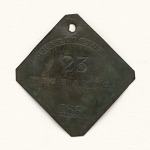Charleston Slave Badge from 1850 for mechanic No.23

Object label: Slave Badges were mandated in 1751, and badge laws soon swept across different cities, especially Charleston, where they were manufactured and sold. These small badges were made of copper, and slaves working in cities during the early 1800s were required to wear them. They only identified the work the slaves were permitted to do, issued annually, and all proceeds went to tax revenue for the city.
For this blog post, I searched the National Museum of African American History and Culture, and I found several interesting objects. However, this piece stood out to me because of how well it shows the dehumanization of slaves. For week three’s Omeka project, I chose a bell rack that was used during this time. These objects show how slave owners looked at slaves, not as humans, but as only income sources. These badges reminded me of a tag that we use on livestock or farm animals, which is honestly hard to comprehend. The label was challenging to complete because there was so much on this topic and I had to determine the most important things to include in 60-80 words.
Today, the silences that occur in museums are due to desensitizing that occurs, especially like slavery, the holocaust, and other sensitive aspects of our history. Early in the class, we learned how it is basically up to the instructor’s discretion in teaching the lesson. This causes confusion and most of the time, we never get the full story. And it’s the same in the museum world; they portray the object by giving information about it in only a small paragraph. People will never quite understand the meaning or importance of these objects to the people of this time,whether positively or negatively. This is not always the museum’s fault; people like to view things that interest them and make them feel good. If everything was shown in a negative light, people might be scared and never visit.
In class, we learned that a persons’ average time in a museum or a particular exhibit is only a small amount of time. I believe most of the time, the object speaks for itself, but labels that are mostly brief 60-80 words are included with each. The Museum can only capture a person’s attention for that small span, and that is why the labels are so short. However, I believe that sometimes particular objects should have longer descriptions for the viewers to read. Then visitors can have the choice to read and retain a lot more information than the brief description.

I really enjoyed reading the object label you created and your additional analysis and interpretations about the silences in museums. Your label added so much depth regarding the significance of the object and would provide viewers a stronger context for understanding this object. I remember your bell-rack object you used in the Omeka site and I think this is another good addition to the kinds of material culture that can speak to the dehumanization of slavery. I also appreciate your acknowledgement of the challenges that museums face. They are often underfunded and lack the people and resources to enact real change in their exhibits. Benefactors can also play a role in the decision-making process, and they may not always be sympathetic to appropriately addressing cultural/historical sensitivity.